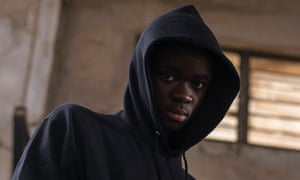‘It has our energy, our story’: asakaa, Ghana’s vibrant drill rap scene
From the US and UK, drill has spread to Ghana, where it provides a voice for the excluded. On the streets of Kumasi, the scene’s MCs tell their story

Ahead of a music video shoot on a leafy street in Kumasi, Ghana’s second city, Yaw Tog and his friends lounge on a kerb. Passersby approach the teenage star for pictures. “Fame is crazy, it came almost overnight,” he says. “I’m proud because I had a vision of what I wanted to do and I did it. Now we’re here.”
A year ago, the 18-year-old could move between classes relatively unnoticed around his high school campus, but his thin and unassuming figure is now impossible to hide. Yaw Tog, currently finishing his exams, is one of the most popular MCs emerging from the city’s booming asakaa scene – a Ghanaian take on the drill subgenre of rap that has earned the city’s young artists thousands of fans around the world.
Drill, a style that pairs huge bass notes with nimble percussion, topped with combative flows, evolved from rap scenes in the US and from grime in London. It has exploded in Ghana over the past 18 months, an underground sound now installed alongside mainstream Afrobeats and pop in the country’s music charts, and attracting guest verses from UK stars including Stormzy. Hit songs cleave closely to the UK’s now-mainstream sound yet have the imprint of Chicago and New York drill, pulsing with dark, brooding tales of a bleak reality in Kumasi’s poorer communities.
In person, Yaw is tender and meek, yet on a video set – and on the mic in his tracks – he seems to slip into an alter-ego. With confidence and controlled aggression, he shapes his hand into a pistol and points it at the camera, delivering lyrics about street life in Kumasi.
In August 2020, Yaw released his single Sore, meaning “rise up” in Twi, the most common indigenous language. Further popularised by a remix with Stormzy (“Like a big brother,” Yaw says) Sore is a swaggering statement track with an organic, off-the-cuff feel, and abrasive lyrics shifting between Twi and English, delivered by Yaw and an array of asakaa artists. It went viral in Ghana, and is now his mum’s phone ringtone. “She doesn’t let me mess around with school so I do music mainly on weekends,” he says. “But she’s definitely proud of me. She shows her friends my songs, my videos. It’s a nice feeling to make her happy.”
Other asakaa tracks such as Jay Bahd’s Condemn, Kofi Jamar’s Ekorso (featuring Yaw Tog) and Smallgod’s Sinner – featuring the UK-Ghanaian drill rapper Headie One – have had millions of views on YouTube and significant radio play in Ghana, whose music industry was slow to embrace the genre but has now cautiously embraced it.
Many of the videos offer a lens into a potent US-inspired subculture that has come alive in Kumasi in recent years – further amplified by the asakaa movement – that reimagines the city with US culture and gang life. Yaw and many in the video brandish red bandanas, partly inspired by LA’s Bloods gang, and Kumasi is hailed as “Kumerika”, with other districts renamed to mirror American cities. Their flag for Kumasi incorporates the US flag’s stars and stripes. The enduring influence of Pop Smoke, the Brooklyn rapper and face of US drill who was killed last year, courses through asakaa. His grunts are slotted into the adlibs, artists such as Jay Bahd sometimes channel his cadence, while others performing the “woo walk” dance he popularised.
Yaw acknowledges the US influence, “but at the same time it’s our own,” he says. “The music is from Kumasi – it has our energy, our story.” Another artist, Don Elvi, chimes in: “It’s our stamp on the culture.” The parallel world of Kumerika uses the US as an imaginative prop, but feels rooted in Kumasi, serving both as a signature of their sound and cultural identity, and a fun escape from their own reality.
At the far end of a road winding upwards along the red soil, past several open and unfinished concrete homes, shanty stores and plots of crops, the rapper O’Kenneth, 22, and a large group of artists and producers get to work on their music at a large compound at the top of a hill overlooking Kumasi’s sprawling landscape. This is the “trap house” – another bit of slang from US culture, meaning somewhere used to prepare and sell drugs. “This is where we make everything, it’s all in-house,” O’Kenneth says, smiling.
Drill artists have since sprung up in Ghana’s capital, Accra, although those in Kumasi seem mildly scornful of them. “As an artist, you used to have to go to Accra to make it,” says O’Kenneth. “But we’re showing you can do it from here and bring the buzz to us.”
The pace of development in Accra has allowed the government to project its desired image of Ghana to the world: a nation on the rise, and a magnet for foreign investment and tourism. Officially named the “year of return”, 2019 marked 400 years since the first African slaves arrived in the US with cultural events that encouraged Ghanaians around the world to forge strong links with their homeland. The country has positioned itself as an attractive landing spot for African Americans and Black middle classes in the west seeking a move to the continent.
Yet much of Ghana’s second city, situated at the heart of the ancient Ashanti kingdom, feels markedly less developed. A mixture of Kumasi’s identity as a proud city with a rich cultural and musical history, the prevalence of poverty, and a widespread sense of anger at the country’s ruling elite make Kumasi the perfect location for drill’s disaffection. “For a fact, we’ve been left behind,” says O’Kenneth. “People feel that neglect from the government. But still, that’s why people really fuck with us, though” – in other words, why young people love their music and show them respect. “They want to put us on the map.”
The rise of drill has brought criticisms that mirror those aimed at the genre in the UK, that the lyrics are a particularly vivid portrayal of violence, to the point of glorifying and inciting it. “It’s ignorance,” O’Kenneth says of such reactions. “There’s been crime here long before – all we’re doing is showing our reality and experience.”
While drill has matured in the UK, with the genre’s first No 1 single and Headie One topping the album charts and performing at the Brit awards, in Kumasi it is still taking off. An asakaa tour of Europe is planned, beginning in Amsterdam, and new collaborations are in the works, too.
Instagram videos posted from Stormzy’s birthday party in late July showed guests hyped as they rap lyrics to Condemn, featuring O’Kenneth. Yaw, on his first trip to London, was present alongside Stormzy, belting Ghanaian drill tracks. “A lot of [UK] artists have shown love. Pa Salieu, BackRoad Gee, many artists. There’s a lot to come for sure,” Yaw says.
Time, his follow-up to Sore,, did well in Ghana’s streaming charts and he’s working on a new album. Dealing with fame has been a process for this self-professed introvert who can no longer blend into the background.
“Everything has happened really fast,” he says. “I’ve had to adapt, change some things in my life, I can’t just go to the same places any more, because they’ll just surround me, even though it’s all love. But I’m blessed for real – I believe it’s only the beginning.”



